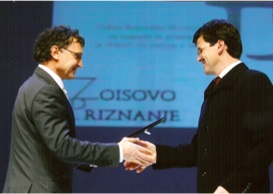 |
 |
||||||||||
HIGHLIGHTS
Prof. Dr. Iztok Arčon received the Pregl award for exceptional achievements in the field of basic and applied research in chemistry and related sciences by the National Institute of Chemistry.

Our research paper about the fate of ecotoxic hexavalent chromium in the environment was presented in Research highlights in HASYLAB anual report 2009 among fiften other most important research achievements in photon science with synchrotron radiation performed at HASYLAB, DESY, Hamburg in 2009.
As a result of a research collaboration between University of Nova Gorica, Institute Jožef Stefan Ljubljana (I. Arčon), Agricultural Research Council-Research Group on Soil-Plant Systems, Gorizia, Italy (L. Leita, A. Margon, A. Pastrello, D. Mosetti), University of Udine (M. Contin) and University of Ljubljana (A. Kodre), we published an article in a scientific review Environmental Pollution about the fate of ecotoxic hexavalent chromium in the environment. The article entitled "Soil humic acids may favour the persistence of hexavalent chromium in soil" was chosen as one of sixteen most important scientific achievements within reasearch with synchrotron radiation at synchrotron radiation center HASYLAB at DESY, Hamburg in the year 2009.
Chromium occurs naturally in the Earth's crust in various oxidation states ranging from 0 to 6+. Hexavalent form of chromium (Cr6+) is extremly toxic and carcinogenic. High amounts of Cr6+ in soil are largely restricted to sites contaminated by human activities. Therefore it is crucial to understand the persistence and fate of hexavalent chromium in the soil system in order to asses the environmental risks at polluted areas.
After entering the soil, Cr6+ remains thermodynamically metastable. In the presence of propitious soil composition and favorable physical conditions it can be reduced to much less toxic and environmentally friendlier trivalent form (Cr3+). Humic acids (natural biopolymers), which form in the soil and water in the process of degradation of organic matter, can significantly affect the uptake, bioavailability, transport, fixation and toxicity of hexavalent chromium in the environment.
Our work focused on the elucidation of the possible interactions of Cr6+ with humic acids by X-ray absorption spectroscopy, performed at synchrotron laboratory HASYLAB, DESY in Hamburg, and by two complementary analytical techniques UV-Vis spectroscopy and DPS voltammetry. The results show that humic acids do not induce reduction of Cr6+ to its trivalent chemical form, as it was expected. On the contrary, the interaction between Cr6+ and humic acids rather increases the persistence of ecotoxic hexavalent chromium in the soil systems, so that it may persist in soils and water for prolonged periods of time, and thus increase environmental risks.
The article:
Liviana Leita, Alja Margon, Arnold Pastrello, Iztok Arcon, Marco Contin, Davide Mosetti,
Soil humic acids may favour the persistence of hexavalent chromium in soil,
Environmental Pollution 157 (2009) 1862-1866,
The research is described in the HASYLAB annual report 2009 - Research highlights:
http://hasylab.desy.de/e81/e245/e247/e74812/e74816/infoboxContent74817/PhotonScience_2009-web_2010-01-05_Final_HB_eng.pdf
Iztok Arčon received Slovenian "Zois award" for outstanding scientific achievements in the field of X-ray absorption spectroscopy in 2006.
E-mail:iztok.arcon@p-ng.si Last change: 02-Oct-2020 |
|||||||||||||||||||||||||||||||||||||||||||||||||||||||||||
